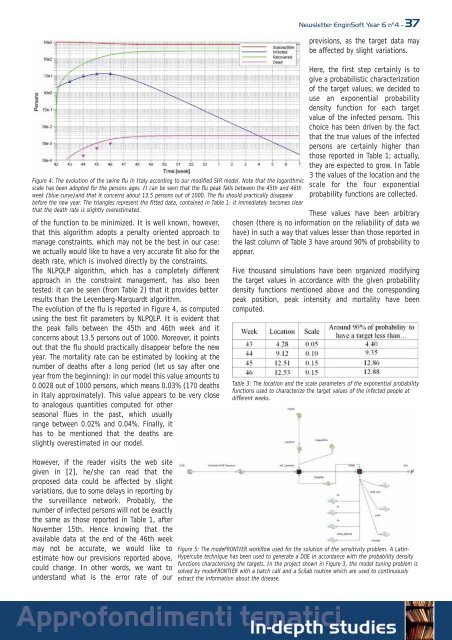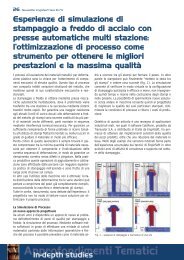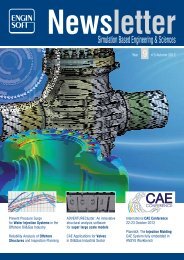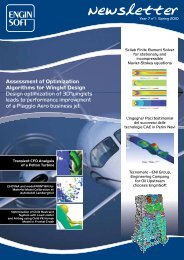software training courses 2010 corsi di addestramento ... - EnginSoft
software training courses 2010 corsi di addestramento ... - EnginSoft
software training courses 2010 corsi di addestramento ... - EnginSoft
You also want an ePaper? Increase the reach of your titles
YUMPU automatically turns print PDFs into web optimized ePapers that Google loves.
Figure 4: The evolution of the swine flu in Italy accor<strong>di</strong>ng to our mo<strong>di</strong>fied SIR model. Note that the logarithmic<br />
scale has been adopted for the persons ages. It can be seen that the flu peak falls between the 45th and 46th<br />
week (blue curve)and that it concerns about 13.5 persons out of 1000. The flu should practically <strong>di</strong>sappear<br />
before the new year. The triangles represent the fitted data, contained in Table 1: it imme<strong>di</strong>ately becomes clear<br />
that the death rate is slightly overestimated.<br />
of the function to be minimized. It is well known, however,<br />
that this algorithm adopts a penalty oriented approach to<br />
manage constraints, which may not be the best in our case:<br />
we actually would like to have a very accurate fit also for the<br />
death rate, which is involved <strong>di</strong>rectly by the constraints.<br />
The NLPQLP algorithm, which has a completely <strong>di</strong>fferent<br />
approach in the constraint management, has also been<br />
tested: it can be seen (from Table 2) that it provides better<br />
results than the Levenberg-Marquardt algorithm.<br />
The evolution of the flu is reported in Figure 4, as computed<br />
using the best fit parameters by NLPQLP. It is evident that<br />
the peak falls between the 45th and 46th week and it<br />
concerns about 13.5 persons out of 1000. Moreover, it points<br />
out that the flu should practically <strong>di</strong>sappear before the new<br />
year. The mortality rate can be estimated by looking at the<br />
number of deaths after a long period (let us say after one<br />
year from the beginning): in our model this value amounts to<br />
0.0028 out of 1000 persons, which means 0.03% (170 deaths<br />
in Italy approximately). This value appears to be very close<br />
to analogous quantities computed for other<br />
seasonal flues in the past, which usually<br />
range between 0.02% and 0.04%. Finally, it<br />
has to be mentioned that the deaths are<br />
slightly overestimated in our model.<br />
However, if the reader visits the web site<br />
given in [2], he/she can read that the<br />
proposed data could be affected by slight<br />
variations, due to some delays in reporting by<br />
the surveillance network. Probably, the<br />
number of infected persons will not be exactly<br />
the same as those reported in Table 1, after<br />
November 15th. Hence knowing that the<br />
available data at the end of the 46th week<br />
may not be accurate, we would like to<br />
estimate how our previsions reported above,<br />
could change. In other words, we want to<br />
understand what is the error rate of our<br />
Newsletter <strong>EnginSoft</strong> Year 6 n°4 - 37<br />
previsions, as the target data may<br />
be affected by slight variations.<br />
Here, the first step certainly is to<br />
give a probabilistic characterization<br />
of the target values; we decided to<br />
use an exponential probability<br />
density function for each target<br />
value of the infected persons. This<br />
choice has been driven by the fact<br />
that the true values of the infected<br />
persons are certainly higher than<br />
those reported in Table 1; actually,<br />
they are expected to grow. In Table<br />
3 the values of the location and the<br />
scale for the four exponential<br />
probability functions are collected.<br />
These values have been arbitrary<br />
chosen (there is no information on the reliability of data we<br />
have) in such a way that values lesser than those reported in<br />
the last column of Table 3 have around 90% of probability to<br />
appear.<br />
Five thousand simulations have been organized mo<strong>di</strong>fying<br />
the target values in accordance with the given probability<br />
density functions mentioned above and the correspon<strong>di</strong>ng<br />
peak position, peak intensity and mortality have been<br />
computed.<br />
Table 3: The location and the scale parameters of the exponential probability<br />
functions used to characterize the target values of the infected people at<br />
<strong>di</strong>fferent weeks.<br />
Figure 5: The modeFRONTIER workflow used for the solution of the sensitivity problem. A Latin-<br />
Hypercube technique has been used to generate a DOE in accordance with the probability density<br />
functions characterizing the targets. In the project shown in Figure 3, the model tuning problem is<br />
solved by modeFRONTIER with a batch call and a Scilab routine which are used to continuously<br />
extract the information about the <strong>di</strong>sease.











